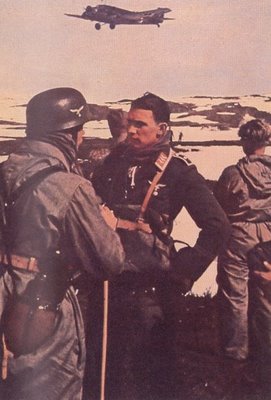 The Combatants V
The Combatants VGerman paratroopers, armored infantry, and Volksgrenadiere
A curious aspect of the German armed forces in the last year of the war was the variety of organizational forms that performed essentially the same function. The emergence of these forms reflected the political infighting of the Third Reich, and in a sense, the units organized as part of these forms were the private armies of high political leaders. Thus, by the end of the war, regular German infantry, Volksgrenadiere (People's Grenadiers), Fallschirmjäger (paratroopers), Luftwaffe infantry, Marine (naval) infantry, SS infantry, and Reichsarbeitdienst (Labor Service) infantry were all fulfulling an infantry combat role in the German armed forces.
Two variants of these, and a legitimately independent form of infantry, the armored infantry, were commonly encountered by allied forces. Indeed, on the western front, perhaps one-half or more all German infantry battalions were Fallschirmjäger, Volksgrenadiere, and Panzergrenadiere (armored grenadiers). For this reason, I wish to discuss these units briefly and point out their weights of fire.
Both the Panzergrenadiere and the Fallschirmjäger had heavy weights of fire, due to the generous allocation of belt-fed machine-guns and automatic anti-aircraft cannon in one or both unit types. A motorized Panzergrenadier battalion could reckon with:
Rifle Kar98, 345 each, 20 rpm, 12.83 grams
Sub MG MP40, 69 each, 150 rpm, 8 grams
Light MG MG42, 54 each, 250 rpm, 12.83 grams
Heavy MG MG42, 12 each, 500 rpm, 12.83 grams
8cm mortar, 6 each, 8 rpm, 3500 grams
12cm mortar, 4 each, 6 rpm, 16000 grams
2cm AA gun, 6 each, 200 rpm, 119 grams
This leads to a one-minute weight of fire of 1,116 Kilograms or 2,456 Pounds. This kind of unit had more than three times the number of belt-fed machine-guns in the front lines as a U. S. infantry battalion. As well, 2cm automatic cannon fired high explosive shells than could produce as many as 20 lethal or incapacitating fragments, sort of a way of saying that each 2cm high-explosive shell was equal to a shower of 20 machine-gun bullets.
The Fallschirmjäger were also very heavily armed:
Rifle Kar98, 216 each, 20 rpm, 12.83 grams
Sub MG MP40, 129 each, 150 rpm, 8 grams
Light MG MG42, 60 each, 250 rpm, 12.83 grams
Heavy MG MG42, 8 each, 500 rpm, 12.83 grams
8cm mortar, 13 each, 8 rpm, 3500 grams
7.5cm recoilless rifle, 2 each, 8 rpm, 5455 grams
This produces a one-minute fire weight of 905 Kilograms or 1,992 pounds. Again, this organization could easily out-shoot any allied infantry battalion it encountered.
The Volksgrenadiere were a late-war expedient meant to reduce manning in infantry units and boost their firepower with more automatic weapons. Although the Volksgrenadiere were German army units, the responsibility for their moral fervor was the province of the SS. The success of this hybid approach was not readily apparent, but in any case, the Volksgrenadiere on average fought as well as any other German army infantry unit. A VG battalion counted the following weapons:
Rifle Kar98, 168 each, 20 rpm, 12.83 grams
Rifle MP43/44, 114 each, 150 rpm, 7.8 grams
Light MG MG42, 27 each, 250 rpm, 12.83 grams
Heavy MG MG42, 8 each, 500 rpm, 12.83 grams
8cm mortar, 6 each, 8 rpm, 3500 grams
7.5cm infantry gun, 4 each, 8 rpm, 6000 grams
The resulting fire weight for one minute was 674 Kilograms or 1,484 pounds. This weight of fire is more on par with allied battalion fire weights, and notably, the Volksgrenadiere did not carry the same reputation for being difficult opponents as the paratroopers or Panzergrenadiere. While the élan of the other two groups played a role, their ability to generate overwhelming firepower was certainly a contributor to their reputation of being dangerous opponents.

0 Comments:
Post a Comment
<< Home